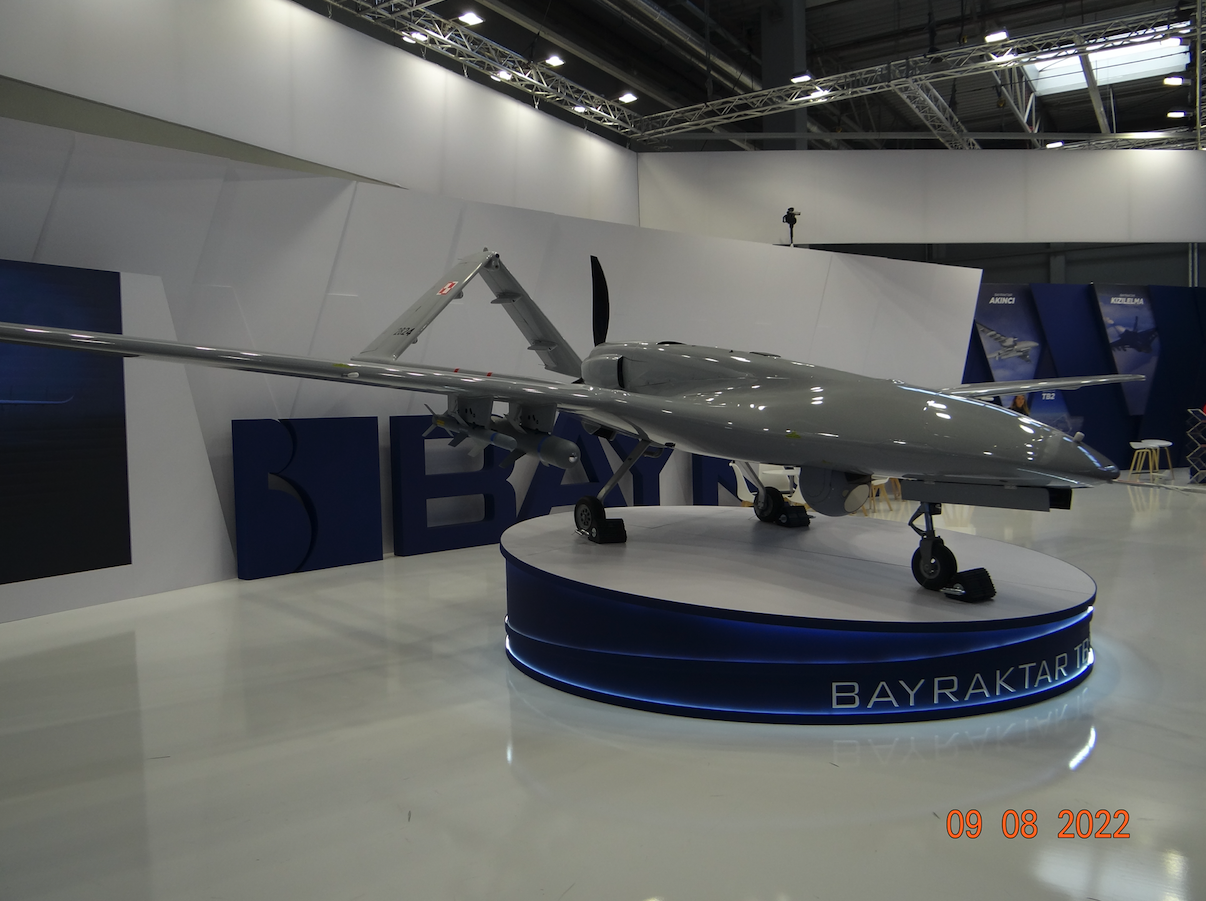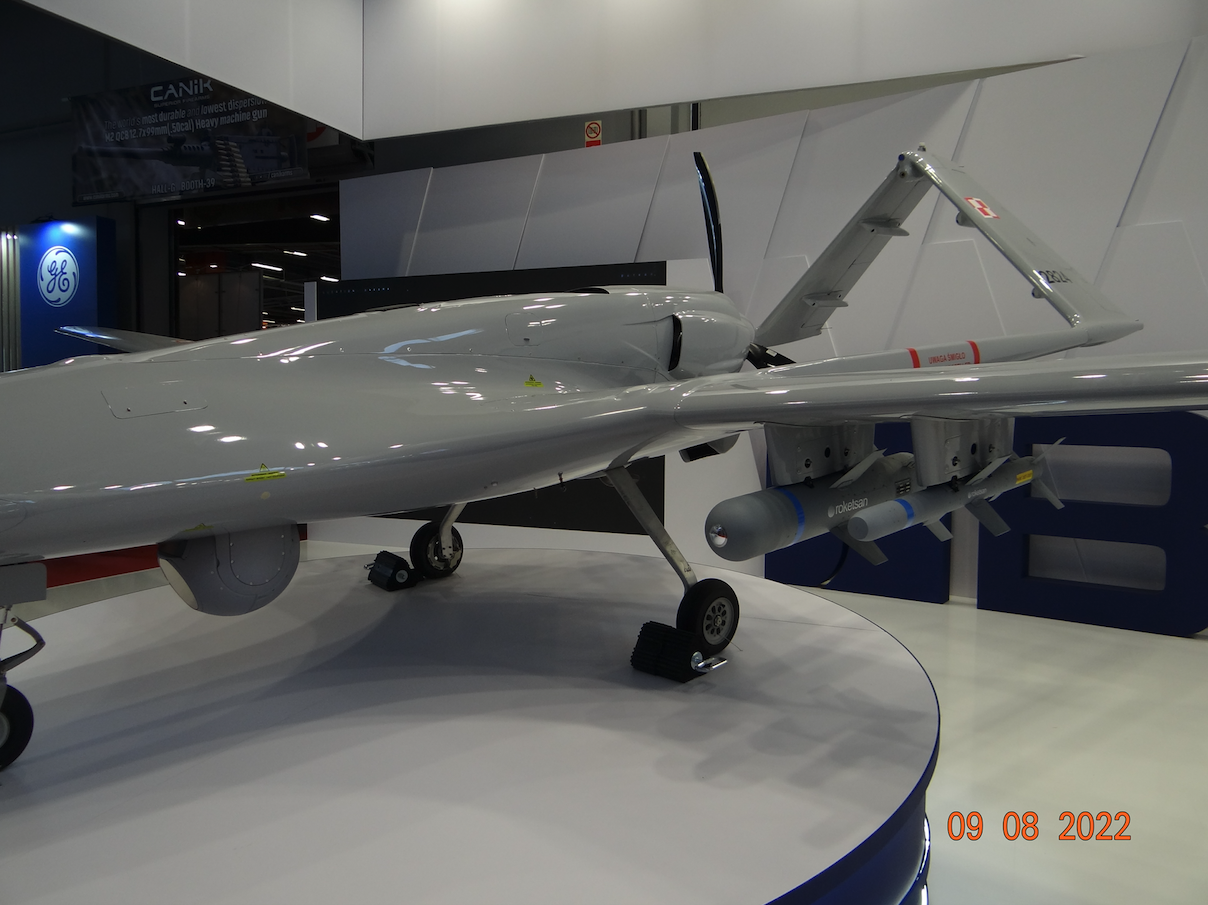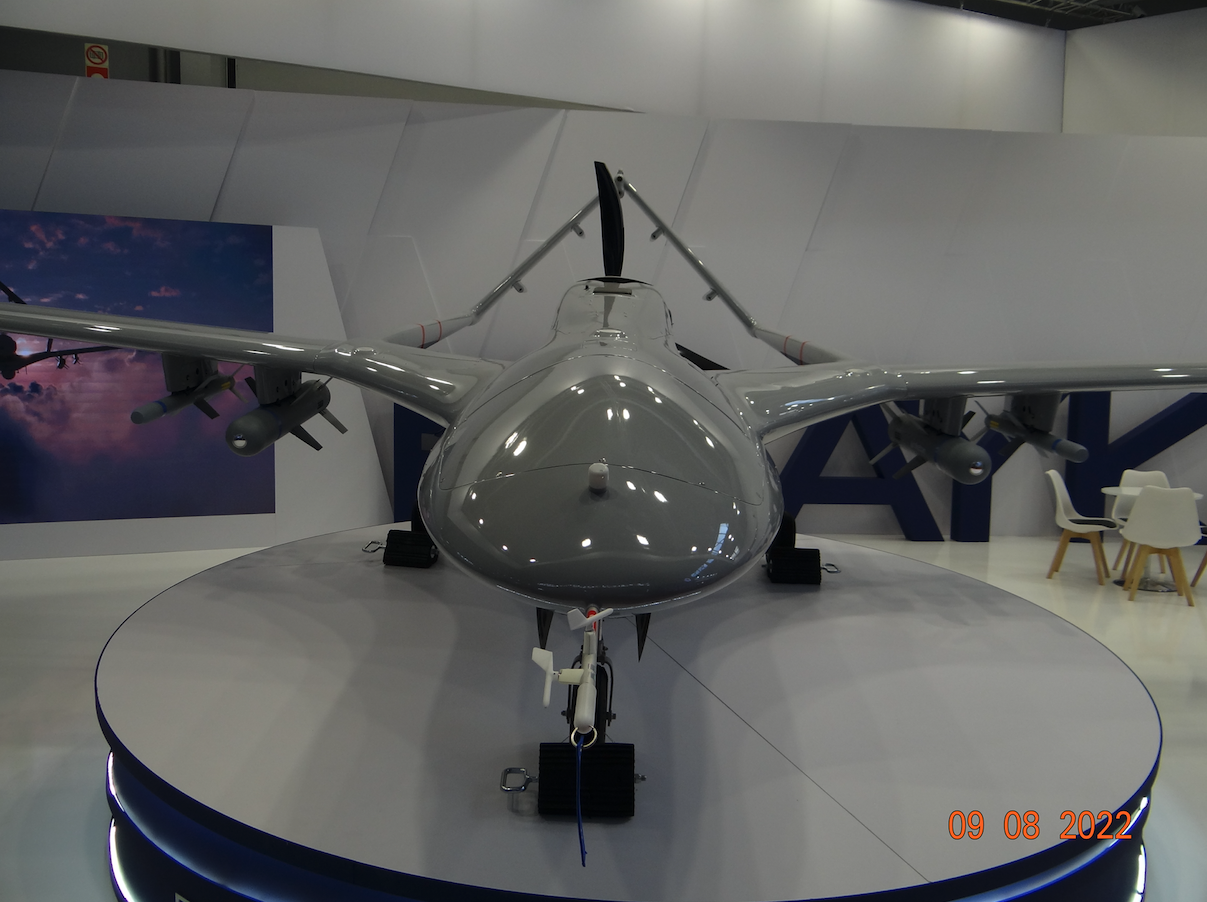BAL Baykar Makina Bayraktar TB2.
BAL oznacza Bezpilotowy Aparat Latający. Bayraktar TB2 jest to turecki bojowy bezzałogowy statek powietrzny przeznaczony do lotów długodystansowych na średnim pułapie. Aparat zdolny jest do samodzielnych operacji lotniczych z możliwością automatycznego startu i lądowania. Na czterech zaczepach pod skrzydłami aparat może przenosić kierowane pociski rakietowe i inne uzbrojenie.
Aparat jest produkowany przez turecką firmę Baykar Makina Sanayi ve Ticaret A.Ş., w skrócie Baykar Makina. Głównym konstruktorem aparatu był Selçuk Bayraktar. Aparat powstał na potrzeby armii tureckiej celem wykorzystania przeciw Kurdom, a także w walkach w Iraku i Syrii. Aparat został już wykorzystany w kilku konfliktach zbrojnych na świecie.
Rozwój aparatu Bayraktar TB2 był spowodowany przez amerykański zakaz eksportu uzbrojonych samolotów bezzałogowych do Turcji, z powodu obaw, że zostaną one użyte przeciwko Kurdom w Turcji i w innych konfliktach na Bliskim Wschodzie. Niestety, Turcja mimo że należy do NATO, prowadzi własną politykę militarną, nie zawsze zgodną z interesami NATO. Na przykład Turcja kupiła pociski rakietowe S-300 w Rosji.
Aparaty Bayraktar TB2 są monitorowane i kontrolowane przez załogę w naziemnej stacji dowodzenia i sterowania, razem z użyciem broni przenoszonej przez BAL. Największym operatorem aparatów latających Bayraktar TB2 jest armia turecka, ale wersje eksportowe zostały sprzedane siłom zbrojnym wielu krajów świata, w tym do Polski.
Firma Baykar Makina rozpoczęła prace nad nowym bezpilotowym systemem bojowym na zlecenie Ministerstwa Przemysłu Obronnego, po doświadczeniach z pierwszym taktycznym bezzałogowym statkiem powietrznym, Bayraktar TB1, który był dostarczony tureckiej armii w 2011 roku. BAL Bayraktar TB2 swój pierwszy lot wykonał w sierpniu 2014 roku. W 2015 roku, przeprowadzono testy z odpalaniem kierowanych pocisków rakietowych z pokładu aparatu. Przeprowadzono także testy użycia bomb naprowadzanych laserowo.
Początkowo aparat wykorzystywał komponenty wielu firm zagranicznych. Na przykład silniki Rotax 912. Kiedy właściciel firmy Rotax – koncern Bombardier – dowiedział się, że cywilny silnik jest wykorzystywany w celach militarnych, wstrzymał eksport tych silników do Turcji. W 2020 roku, koncern Bombardier zweryfikował kraje którym były sprzedawane silniki Rotax i wykreślił z listy kraje, które nie dotrzymywały zawartych umów. Silniki Rotax są produkowane w fabryce w Austrii. Podobnie stało się z głowicą oto-elektroniczną, która była produkowana przez firmę Wescam w Kanadzie.
Były podejrzenia, że w opracowaniu i produkcji aparatu Bayraktar TB2 pracowały firmy z UK. Jednak szefowie firmy Baykar Makina stanowczo temu zaprzeczyli. Chodziło o zaczepy uzbrojenia montowane pod skrzydłami. Turcy powiedzieli, że ten system jest ich oryginalnym. Natomiast w 2020 roku, brytyjski Departament Handlu Międzynarodowego ujawnił szczegóły współpracy z Turcją, sugerując, że nie było transferu krytycznej technologii do Turcji.
W październiku 2020 roku, ujawniono użycie kanadyjskiego systemu oto-elektronicznego Wescam MX-15D w aparacie Bayraktar TB2. Dokonali tego Ormianie po straceniu aparatu i wydobyciu z jego wraku systemu MX-15D. Kanada wstrzymała dostawy, a Turcja oświadczyła, że ma już własne zamienniki. Jednak większość klientów na aparaty Bayraktar TB2, w tym Ukraina, Polska, Maroko i Kuwejt, odmówiła zakupu głowicy elektrooptycznej Aselsan CATS (Turcja) i zdecydowała się zamówić głowice Wescam MX-15D przez autoryzowanego dystrybutora. Jedną z przyczyn jest wzrost masy głowicy z 45 kg do 61 kg (99 do 134 funtów) i gorsze parametry optyczne.
Szacuje się, że jeden aparat Bayraktar TB2 kosztuje 5 milionów dolarów. Firma nie podaje ceny, bo wszystko jest zależne od ilości zakupionych BAL, ilości stacja kontroli (GCS), symulatorów oraz zamówionego uzbrojenia.
W 2021 roku, Polskie Siły Powietrzne zamówiły 24 aparaty, dzięki czemu Polska była pierwszym krajem NATO (poza Turcją) i UE, który kupił Bayraktar TB2. Pierwsza partia aparatów i stanowisk kierowania została dostarczona w 2022 roku.
W 2022 roku, BAL Bayraktar TB2 dobrze spisały się w wojnie obronnej Ukrainy, przeciw bandyckiej rosji, która w dniu 24 lutego 2022 roku, napadła na suwerenną Ukrainę.
Konstrukcja Bayraktar TB2.
Płatowiec jest wykonany z kompozytów (włókno węglowe) i częściowo z aluminium. Kadłub aparatu jest typu szczątkowego, bardzo spłaszczony dla wytwarzania dodatkowej siły nośnej. Skrzydła są o małej cięciwie i dużej rozpiętości. Ze skrzydeł wyprowadzono dwie belki ogonowe do których zamontowano stateczniki w kształcie odwróconej litery „V”. W szczycie usterzenia umieszczono kamery, dla obserwacja samolotu, zwłaszcza w chwili startu i lądowania. Silnik spalinowy umieszczono w tyle kadłuba i porusza on 3-łopatowe śmigło. Paliwo jest umieszczone w miękkich zbiornikach. Elektronika czuwa nad właściwą kolejnością opróżniania zbiorników, aby aparat był cały czas wyważony.
Pod skrzydłami umieszczono cztery zaczepy dla uzbrojenia: bomby kierowane i kierowane pociski rakietowe. Całe uzbrojenie jest klasy powietrze – ziemia (powietrze – woda).
Aparat ma stałe podwozie główne, dwugoleniowe, z pojedynczymi kołami oraz podwozie przednie chowane do kadłuba. Wystające przednie podwozie utrudnia korzystanie z głowicy oto-elektronicznej, która jest umieszczona pod kadłubem.
Aparat jest wyposażony w instalację elektryczną z akumulatorami litowo-jonowymi oraz alternator. Aparat jest wyposażony w układ nawigacji bezwładnościowej, który umożliwia powrót na lotnisko startu, nawet przy całkowicie utraconej łączności. W nawigacji standardowo jest wykorzystywany układ GPS.
Naziemna stacja kontroli (GCS) jest oparta na jednostce schronowej, typu mobilnego, zgodnej ze specyfikacją NATO, która jest wyposażona w systemy dowodzenia i kontroli. Jeden BAL obsługują trzy osoby: pilot, operator ładunku i dowódca misji. Każdy operator ma dwa ekrany przed sobą wraz z oprogramowaniem interfejsu operatora używanym do dowodzenia, kontroli i monitorowania w czasie rzeczywistym.
Dane T-T Bayraktar TB2:
Długość 6.5 m (21 ft 4 in). Rozpiętość 12 m (39 ft 4 in). Masa startowa 700 kg (1,500 lb). Masa ładunku 150 kg (330 lb). Zapas paliwa 300 litrów (79 US gal). Silnik spalinowy cztero-cylindrowy, czterosuwowy, o mocy 100 KM (75 kW). Prędkość maksymalna 120 knots (220 km/h). Prędkość przelotowa 70 knots (130 km/h). Zasięg maksymalny ponad 4,000 km (2,200 nmi). Pułap operacyjny 25,000 ft (7,600 m). Czas lotu do 27 godzin.
Opracował Karol Placha Hetman



